Key takeaways:
- Open dialogue between children and adults fosters trust and encourages children to express their concerns, highlighting the importance of creating a safe space for communication.
- Shared experiences among caregivers and parents can create powerful connections, revealing common challenges and insights that enhance child safeguarding practices.
- Establishing trust through consistent feedback and informal gatherings allows for more authentic conversations, making individuals feel valued and heard.
- Active listening and empathy are critical in facilitating effective dialogue, enabling deeper understanding and connection among participants.
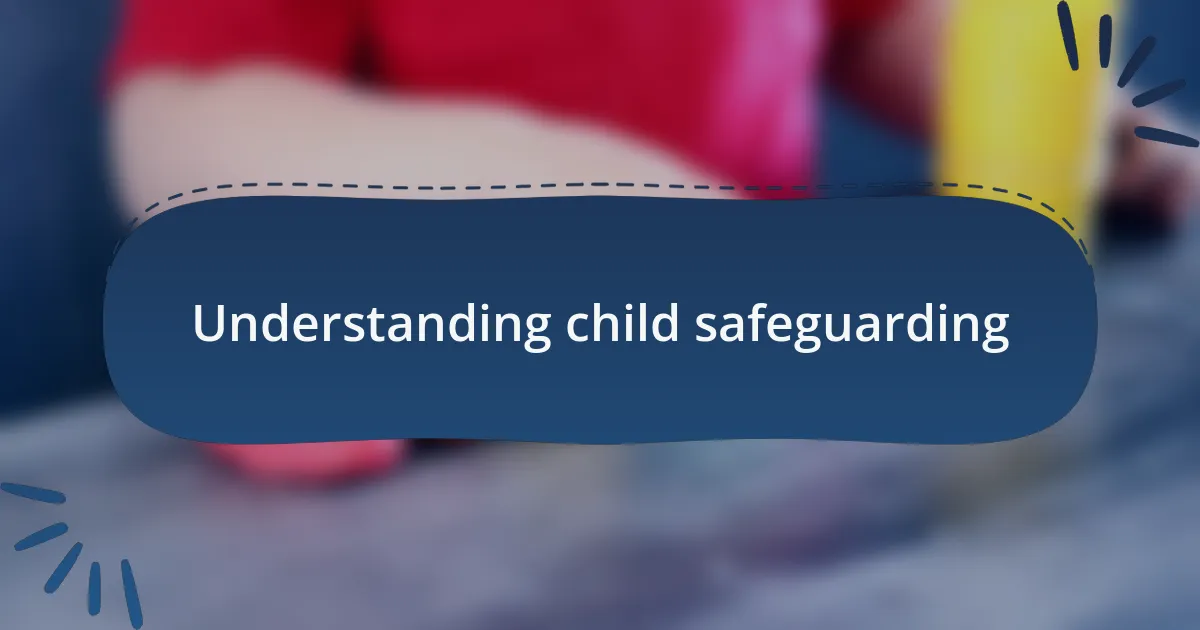
Understanding child safeguarding
Understanding child safeguarding is more than just a set of policies; it requires us to create a culture of care and respect around children. Reflecting on my experiences, I’ve seen firsthand how open dialogues can foster trust between children and adults, encouraging them to speak up about their concerns. Have you ever thought about the power of listening? Sometimes, just giving a child a safe space to express their fears can make a world of difference.
When I think about child safeguarding, I am reminded of a workshop I attended where we discussed the signs of emotional abuse. It struck me how often these signs can be subtle, blending into a child’s everyday life. If we didn’t take the time to educate ourselves on these signs, how would we ever recognize a cry for help? Understanding these nuances is crucial in ensuring that we protect children effectively.
Every child deserves the right to grow up in a safe environment where they feel valued and protected. It’s heartbreaking to consider the countless children who go unheard because of barriers to communication. How can we, as a community, break down these barriers? The answer lies in our collective efforts to prioritize safeguarding, listen actively, and respond compassionately.
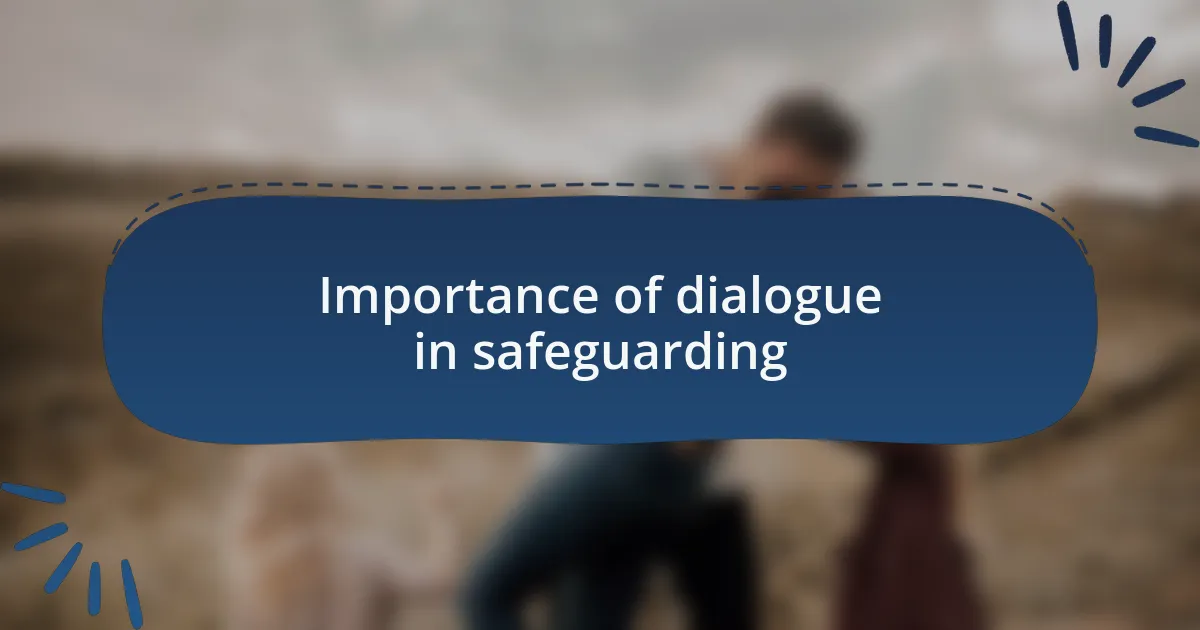
Importance of dialogue in safeguarding
Creating spaces for dialogue in safeguarding is crucial because it empowers children to share their experiences and feelings. I recall a time when a young girl opened up about her challenges only after I asked her a simple question: “What makes you feel safe?” That moment highlighted how vital it is to encourage conversations where children can articulate their thoughts without fear of judgment.
Additionally, I’ve noticed that dialogue fosters a sense of community and shared responsibility. In one of the parent meetings I facilitated, a father expressed his worries about his child’s friendships. By encouraging discussions among parents, we transformed individual concerns into collective action, strengthening our commitment to child safeguarding. It made me realize that when we engage in dialogue, we not only support children but also each other.
Isn’t it interesting how much a simple conversation can change everything? When adults actively listen to children, we create a safe environment, allowing them to feel heard and valued. This act of listening can often reveal underlying issues that might otherwise remain hidden, reminding us that dialogue is not just important; it’s a lifeline for those who need support the most.
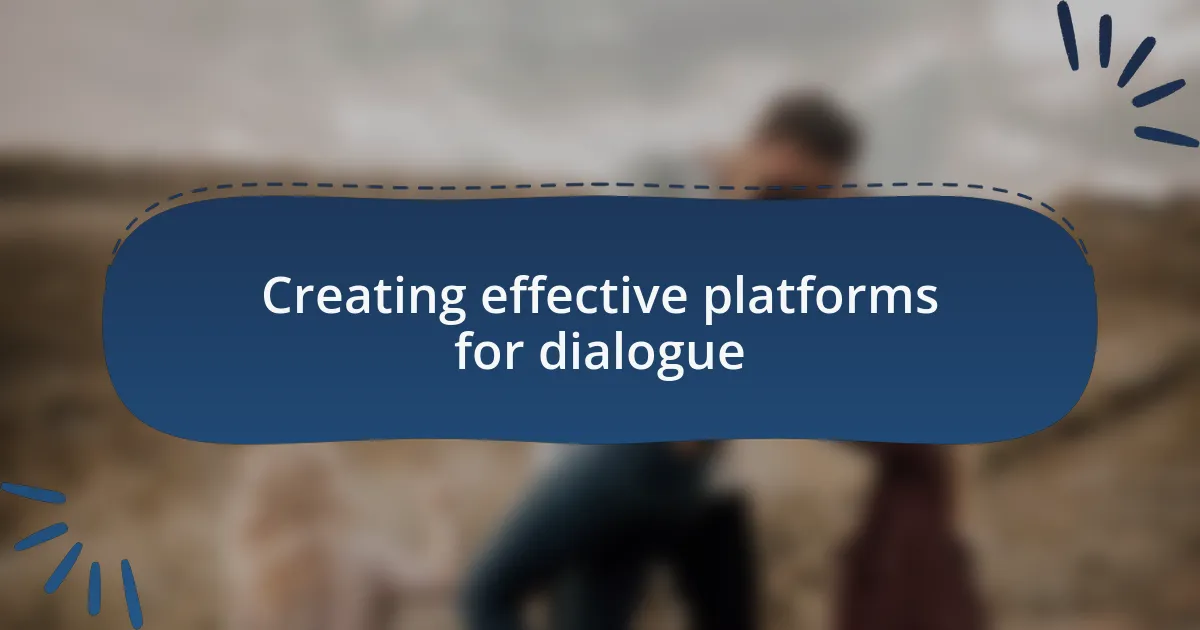
Creating effective platforms for dialogue
Creating effective platforms for dialogue starts with establishing trust. I remember attending a workshop focused on child safety where facilitators encouraged open discussions. By sharing my own experiences and vulnerabilities, I noticed how others began to open up too. This exchange created an environment where everyone felt safe to voice their concerns, and it became clear that vulnerability can be a powerful catalyst for dialogue.
Another key aspect is accessibility. I once volunteered at a community center where we designed a simple feedback box for children. The box was decorated with colorful drawings to attract attention, and it allowed kids to anonymously share their thoughts. This method proved incredibly effective. It demonstrated that when children feel they can communicate without direct confrontation, the result is often a flood of insights and feelings that can inform our safeguarding strategies.
Have you ever considered how crucial our choice of words can be in initiating dialogue? During a conversation with a group of teenagers about their online safety, I learned that framing questions positively encouraged them to share more openly. Instead of asking, “What worries you online?” I shifted to, “What do you enjoy about your online experiences?” This small change opened up a dialogue that not only highlighted their joys but also naturally led to discussions about their safety concerns. It reinforced my belief that effective platforms for dialogue are built on understanding and framing questions that inspire rather than inhibit.
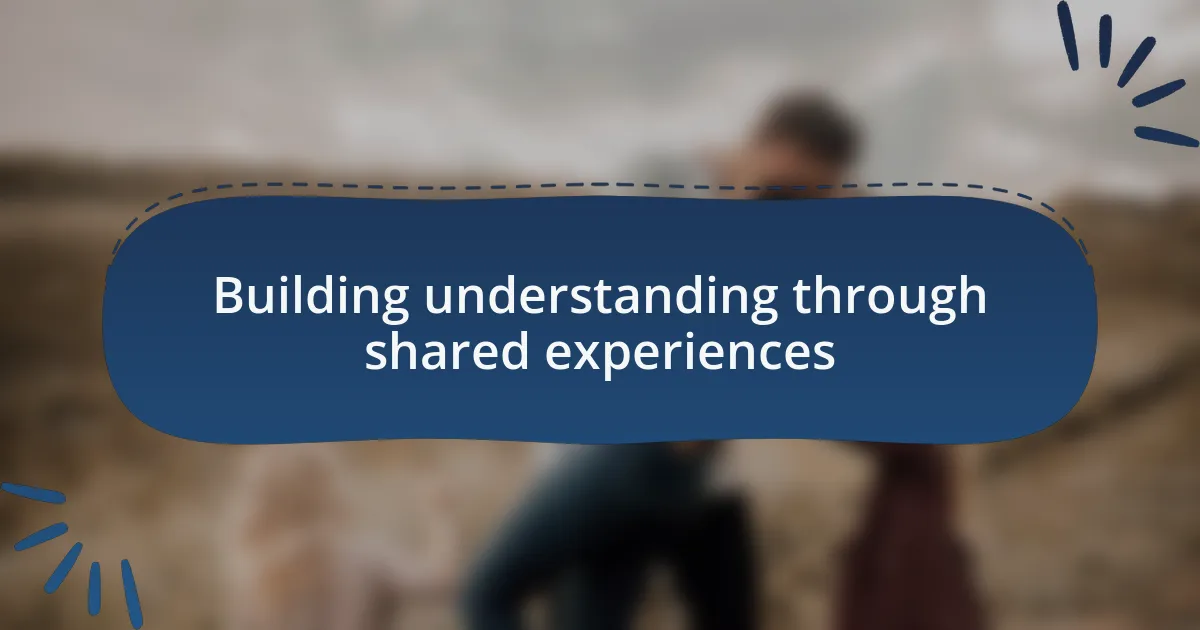
Building understanding through shared experiences
Building understanding through shared experiences is akin to creating a tapestry woven from individual threads of life. I recall a story shared by a mother at a meeting dedicated to child safeguarding. She spoke about her struggles and triumphs, and as she did, I could see the expressions of recognition on the faces of others. It was a powerful moment; her vulnerability served as a bridge, bringing us all closer together and fostering a deeper sense of empathy within the group.
In another instance, I organized a small gathering with caregivers to discuss their challenges. At first, there was hesitance in the room, with everyone tiptoeing around their feelings. But once one caregiver shared her experience of feeling overwhelmed, it was as if a floodgate had opened. Each person soon began recounting their own stories, revealing insights and solutions that we could later implement in our safeguarding practices. This demonstrated to me that shared experiences are not just about storytelling; they’re about mutual support and learning.
Have you ever noticed how sharing a simple joy or concern can feel liberating? I once joined an online forum dedicated to child safeguarding, where participants exchanged personal stories about their successes and setbacks. The candid nature of these exchanges made me realize how important it is to create environments where individuals feel empowered to express themselves. Such spaces foster understanding, allowing us to learn from one another’s journeys, and I believe that’s where true growth begins.
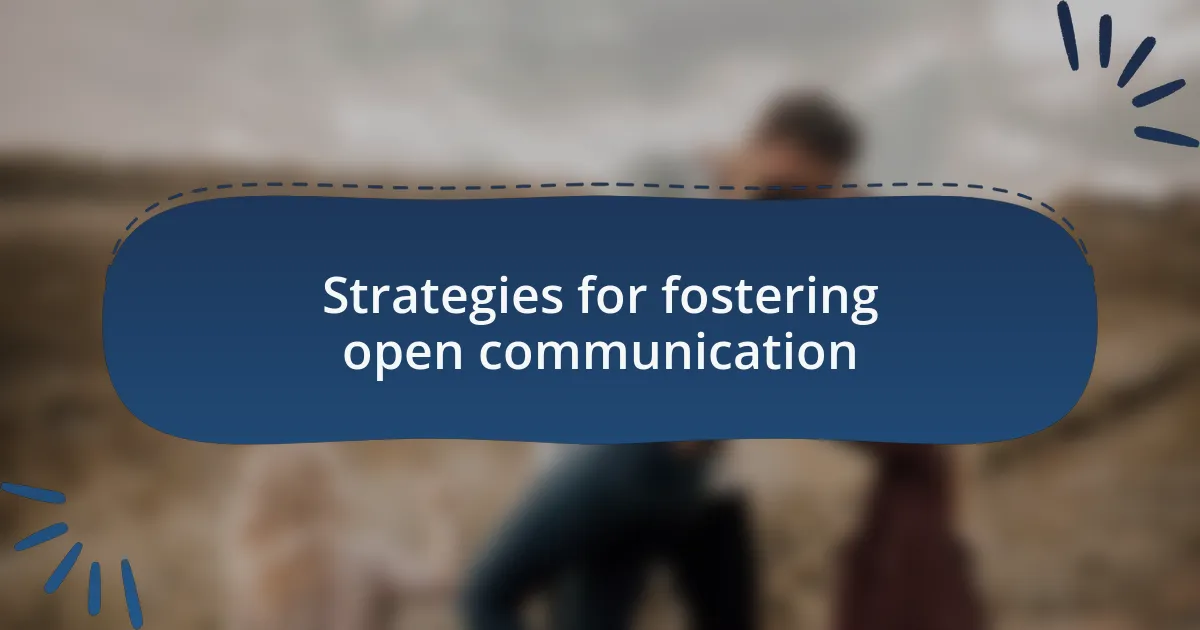
Strategies for fostering open communication
One vital strategy for fostering open communication is to establish a regular feedback loop. In my experience with a local child protection initiative, we implemented monthly check-ins where both staff and caregivers could voice their thoughts. Initially, I was surprised by how many people had hesitations about expressing their concerns. However, as trust developed through these consistent interactions, individuals began to open up more, leading to actionable insights that helped us refine our approach.
Another approach that proved remarkably effective was the use of informal gatherings. I once hosted a “coffee chat” series where parents could come and discuss various topics related to child safeguarding in a relaxed setting. I found that without the pressure of formalities, the atmosphere allowed for more genuine conversations. Parents felt free to share their questions and fears, which not only led to richer discussions but also strengthened the community bond.
What about those moments when someone feels most comfortable sharing? I remember a time when I encouraged a quiet participant to share her thoughts during a workshop. After a little prompting, she expressed deep-seated concerns that resonated with everyone in the room. It reminded me that sometimes, we just need to create that small opening for individuals to feel seen and heard, thus fostering a culture where everyone feels their voice matters.
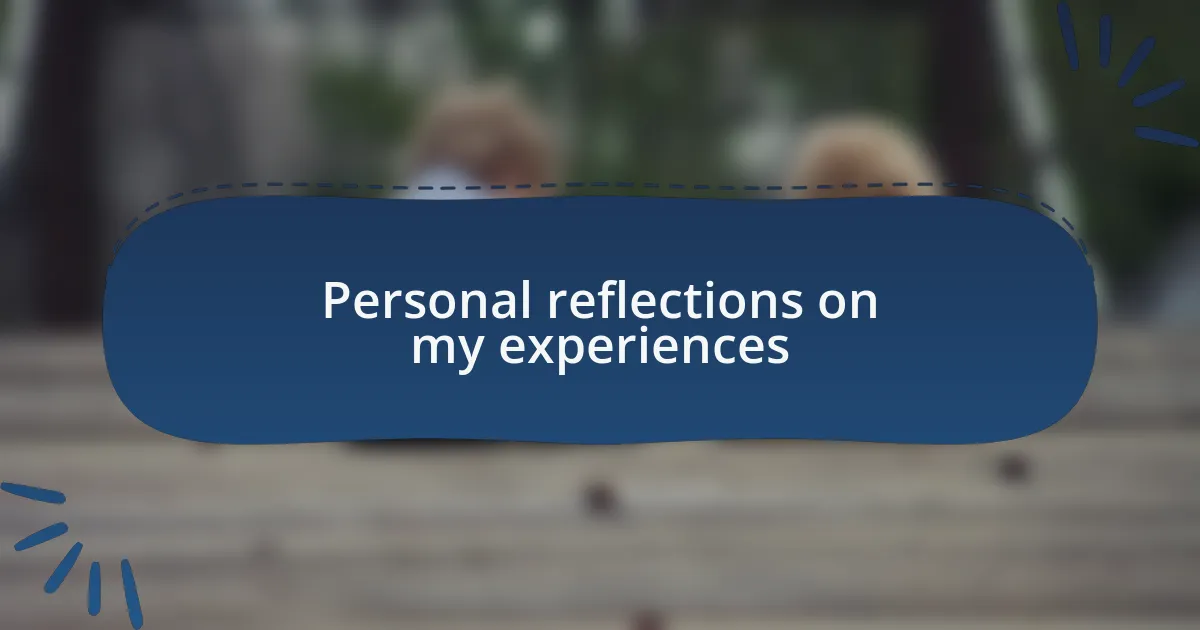
Personal reflections on my experiences
Reflecting on my journey in creating platforms for dialogue, I remember the first community meeting I facilitated. My heart raced as I watched skeptical faces in the crowd; I wondered if they would even find value in this gathering. When one participant hesitantly shared her story about a troubling experience, the air shifted. It was a poignant reminder that sharing vulnerabilities can light the path for others, revealing the power of open dialogue.
One experience that stands out was during a workshop designed to foster understanding among caregivers. I asked participants to pair up and share their challenges. As I moved around the room, I saw walls crumbling with each honest exchange. It struck me how these moments of connection not only provided relief but also ignited collective ideas for solutions. What if we named this process “shared insight,” emphasizing our collective strength? The energy that followed was palpable and reaffirmed my belief that dialogue can bridge divides.
I often think about the realization that not every conversation yields immediate results. Once, during a particularly difficult discussion about sensitive safeguarding issues, I felt frustrated by the lack of engagement. However, in the days that followed, several participants approached me individually, expressing thoughts they were initially afraid to share in the group. It made me see that the seeds of trust often take time to grow, and sometimes silence is just a precursor to deeper understanding. How powerful it is to know that dialogue, in its many forms, can quietly shape change over time!
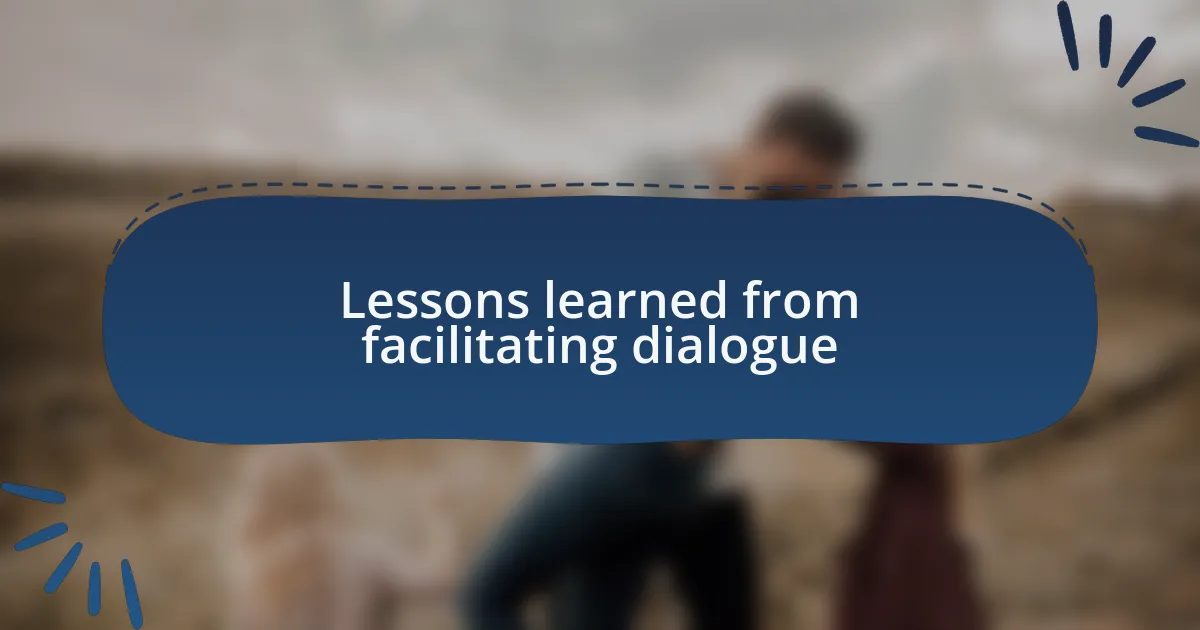
Lessons learned from facilitating dialogue
Facilitating dialogue taught me the invaluable lesson that listening is just as crucial as speaking. I recall a time when I encouraged everyone to share their thoughts in a roundtable format. Initially, I found myself overly focused on prompting others to speak rather than truly absorbing what was being said. The moment I shifted to active listening, pausing to digest their words, I noticed the conversation blossomed. Isn’t it interesting how allowing space for silence can invite more profound insights?
Another lesson emerged from a workshop where I experimented with role reversal. Participants took turns stepping into each other’s shoes to express diverse perspectives on child safeguarding. The laughter and tears that followed were nothing short of enlightening. It made me realize how empathy could shatter preconceived notions, nurturing a deeper bond. How often do we truly consider another’s view? By creating a safe environment for such exchanges, we can foster understanding and compassion among the group.
Lastly, I learned the importance of maintaining flexibility in dialogue. During one session, I sensed the group veering off-topic. Instead of steering them back forcefully, I embraced the tangent, allowing it to unfold naturally. This unexpected shift revealed deeper emotions and issues that had been simmering beneath the surface. Was this a diversion or an opportunity? In hindsight, it became clear that these moments of spontaneity can often lead to the most impactful conversations, guiding us toward genuine understanding.